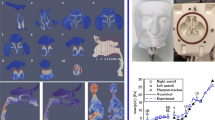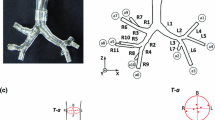Abstract
In this study, flow field characteristics in the trachea region in a realistic human upper airway model were firstly measured by particle image velocimetry (PIV) in the air under three constant inhalation and exhalation conditions: 36 L/min, 64 L/min and 90 L/min, representing flow rates of 18 L/min, 32 L/min and 45 L/min in real human airway (the model was twice the size of a human airway). Computational fluid dynamics (CFD) analyses were performed on four turbulence models, with boundary conditions corresponding to the PIV experiments. The effects of flow rates and breathing modes on the airflow patterns were investigated. The CFD prediction results were compared with the PIV measurements and showed relatively good agreement in all cases. During inhalation, the higher the flow rates, the less significant the “glottal jet” phenomenon, and the smaller the area of the separation zone. The air in the nasal inhalation condition accelerated more dramatically after glottis. The SST-Transition model was the best choice for predicting inhalation velocity profiles. For exhalation condition, the maximum velocity was much smaller than that during inhalation due to the more uniform flow field. The exhalation flow rates and breathing modes had little effect on the flow characteristics in the trachea region. The RNG k − ε model and SST k − ω model were recommended to simulate the flow field in the respiratory tract during exhalation.













Similar content being viewed by others
References
Abe K, Kondcjh T (1994) A new turbulence model for predicting fluid flow and heat transfer in separating and reattaching flows. Int J Heat Mass Transf 37(1):139–151
Azarnoosh J, Sreenivas K, Arabshahi A (2016) CFD investigation of human tidal breathing through human airway geometry. Procedia Comput Sci 80:965–976. https://doi.org/10.1016/j.procs.2016.05.392
Bourell DL, Beaman JJ, Klosterman D, Gibson I, Bandyopadhyay A (2001) Rapid prototyping. ASM Handb 21:383–387. https://doi.org/10.1361/asmhba0003397
Cheng T, Carpenter D, Cohen S, Witsell D, Frank-Ito DO (2018) Investigating the effects of laryngotracheal stenosis on upper airway aerodynamics. Laryngoscope 128:E141–E149. https://doi.org/10.1002/lary.26954
Conway J et al (2012) Controlled, parametric, individualized, 2-D and 3-D imaging measurements of aerosol deposition in the respiratory tract of healthy human subjects for model validation. J Aerosol Sci 52:1–17. https://doi.org/10.1016/j.jaerosci.2012.04.006
Deng Q, Ou C, Shen YM, Xiang Y, Miao Y, Li Y (2019) Health effects of physical activity as predicted by particle deposition in the human respiratory tract. Sci Total Environ 657:819–826. https://doi.org/10.1016/j.scitotenv.2018.12.067
Doorly DJ, Taylor DJ, Gambaruto AM, Schroter RC, Tolley N (2008a) Nasal architecture: form and flow. Philos Trans A Math Phys Eng Sci 366:3225–3246. https://doi.org/10.1098/rsta.2008.0083
Doorly DJ, Taylor DJ, Schroter RC (2008b) Mechanics of airflow in the human nasal airways. Respir Physiol Neurobiol 163:100–110. https://doi.org/10.1016/j.resp.2008.07.027
Elcner J, Lizal F, Jedelsky J, Jicha M, Chovancova M (2016) Numerical investigation of inspiratory airflow in a realistic model of the human tracheobronchial airways and a comparison with experimental results. Biomech Model Mechanobiol 15:447–469. https://doi.org/10.1007/s10237-015-0701-1
Frank-Ito DO, Schulz K, Vess G, Witsell DL (2015) Changes in aerodynamics during vocal cord dysfunction. Comput Biol Med 57:116–122. https://doi.org/10.1016/j.compbiomed.2014.12.004
Golshahi L, Noga ML, Vehring R, Finlay WH (2013) An in vitro study on the deposition of micrometer-sized particles in the extrathoracic airways of adults during tidal oral breathing. Ann Biomed Eng 41:979–989. https://doi.org/10.1007/s10439-013-0747-0
Gu X, Wen J, Wang M, Jian G, Zheng G, Wang S (2019) Numerical investigation of unsteady particle deposition in a realistic human nasal cavity during inhalation. Exp Comput Multiph Flow 1:39–50. https://doi.org/10.1007/s42757-019-0007-0
Guarnieri M, Balmes JR (2014) Outdoor air pollution and asthma The Lancet 383:1581–1592. https://doi.org/10.1016/s0140-6736(14)60617-6
Heenan AF, Matida E, Pollard A, Finlay WH (2003) Experimental measurements and computational modeling of the flow field in an idealized human oropharynx. Exp Fluids 35:70–84. https://doi.org/10.1007/s00348-003-0636-7
Hopkins LM, Kelly JT, Wexler AS, Prasad AK (2000) Particle image velocimetry measurements in complex geometries. Exp Fluids 29:91–95
Jayaraju ST, Paiva M, Brouns M, Lacor C, Verbanck S (2008) Contribution of upper airway geometry to convective mixing. J Appl Physiol (1985) 105:1733–1740. https://doi.org/10.1152/japplphysiol.90764.2008
Kim SK, Chung SK (2004) An investigation on airflow in disordered nasal cavity and its corrected models by tomographic PIV. Meas Sci Technol 15:1090–1096. https://doi.org/10.1088/0957-0233/15/6/007
Kim KH, Kabir E, Kabir S (2015) A review on the human health impact of airborne particulate matter. Environ Int 74:136–143. https://doi.org/10.1016/j.envint.2014.10.005
Lin J, et al. (2010) Numerical simulation of inhaled aerosol particle deposition within 3D realistic human upper respiratory tract. In: Paper presented at the AIP conference proceeding, vol 1207, no 1, pp 992
Mason EC, McGhee S, Zhao K, Chiang T, Matrka L (2019) The application of computational fluid dynamics in the evaluation of laryngotracheal pathology. Ann Otol Rhinol Laryngol 128:453–459. https://doi.org/10.1177/0003489419826601
Menter FR, Kuntz M, Langtry R (2003) Ten years of industrial experience with the SST turbulence model. Turbul Heat Mass Transf 4:625–632
Menter FR, Langtry R, Völker S (2006) Transition modelling for general purpose CFD codes flow. Turbul Combust 77:277–303. https://doi.org/10.1007/s10494-006-9047-1
Morris RD (2001) Airborne particulates and hospital admissions for cardiovascular disease a quantitative review of the evidence. Environ Health Perspect 109(4):495–500
Peltola SM, Grijpma DW, Melchels FP, Kellomäki M (2008) A review of rapid prototyping techniques for tissue engineering purposes. QUT Digit Repos 40:268–280. https://doi.org/10.1080/07853890701881788
Phuong NL, Ito K (2015) Investigation of flow pattern in upper human airway including oral and nasal inhalation by PIV and CFD. Build Environ 94:504–515. https://doi.org/10.1016/j.buildenv.2015.10.002
Phuong NL, Yamashita M, Yoo S-J, Ito K (2016) Prediction of convective heat transfer coefficient of human upper and lower airway surfaces in steady and unsteady breathing conditions. Build Environ 100:172–185. https://doi.org/10.1016/j.buildenv.2016.02.020
Shang Y, Dong J, Tian L, Inthavong K, Tu J (2019) Detailed computational analysis of flow dynamics in an extended respiratory airway model. Clin Biomech (Bristol, Avon) 61:105–111. https://doi.org/10.1016/j.clinbiomech.2018.12.006
Spence CJT, Buchmann NA, Jermy MC, Moore SM (2010) Stereoscopic PIV measurements of flow in the nasal cavity with high flow therapy. Exp Fluids 50:1005–1017. https://doi.org/10.1007/s00348-010-0984-z
Spence CJT, Buchmann NA, Jermy MC (2011) Unsteady flow in the nasal cavity with high flow therapy measured by stereoscopic PIV. Exp Fluids 52:569–579. https://doi.org/10.1007/s00348-011-1044-z
Sun XZ, Yu C, Liu Y-X, Zhang J, SU Y-F (2006) 3D finite element model reconstruction and numerical simulation of airflow in human upper air. Space Med Med Eng 19(2):129–133
Tian L, Inthavong K, Liden G, Shang Y, Tu J (2016) Transport and deposition of welding fume agglomerates in a realistic human nasal airway. Ann Occup Hyg 60:731–747. https://doi.org/10.1093/annhyg/mew018
Villafruela JM, Olmedo I, de Adana MR, Méndez C, Nielsen PV (2013) CFD analysis of the human exhalation flow using different boundary conditions and ventilation strategies. Build Environ 62:191–200. https://doi.org/10.1016/j.buildenv.2013.01.022
Xu XY, Ni SJ, Fu M, Zheng X, Luo N, Weng WG (2017) Numerical investigation of airflow, heat transfer and particle deposition for oral breathing in a realistic human upper airway model. J Therm Biol 70:53–63. https://doi.org/10.1016/j.jtherbio.2017.05.003
Yakhot V, Orszag SA (1986) Renormalization group analysis of turbulence. J Sci Comput 1(1):3–51
Funding
This study was supported by National Natural Science Foundation of China (Grant No. 51706123), National Science Fund for Distinguished Young Scholars of China (Grant No 71725006) and National Key R&D Program of China (Grant Nos. 2016YFC0802801 and 2016YFC0802807).
Author information
Authors and Affiliations
Corresponding author
Ethics declarations
Conflict of interest
The authors declare that they have no conflict of interest.
Additional information
Publisher's Note
Springer Nature remains neutral with regard to jurisdictional claims in published maps and institutional affiliations.
Rights and permissions
About this article
Cite this article
Xu, X., Wu, J., Weng, W. et al. Investigation of inhalation and exhalation flow pattern in a realistic human upper airway model by PIV experiments and CFD simulations. Biomech Model Mechanobiol 19, 1679–1695 (2020). https://doi.org/10.1007/s10237-020-01299-3
Received:
Accepted:
Published:
Issue Date:
DOI: https://doi.org/10.1007/s10237-020-01299-3




